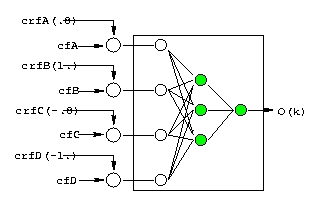 |
 |
![]()
![]()
Each effective input for the net, is the product of certainty factor of the premises, with their corresponding frequency degrees (0.8 for "often, +1.0 for always..):
Figure 38: Net representation of knowledge ``(often
A and always B) or (seldom C and never D)"

The deactivation of an input is performed by assigning a zero value
to ![]() .
.
After the presentation of the context of the pixel to all nets (corresponding to all rules), the system produces realization degrees of each rule. The result is contained in a vector S which will be combined with another vector R obtained by a neural network classification process using radiometric information.
These two types of data are considered as two different information sources on the same object, and their combination uses the Dempster 's orthogonal rule. The uncertainty factor, for the classification of one pixel in a given source is estimated by the separability of realization degrees among classes (Sep).
We consider the following notations:
R and S will be mapped to mass distribution vectors R'
and S'. So, ![]() and
and ![]() .
.
with
The new mass distribution is computed with the Dempster orthogonal rule T=R'S':
|
We then define the support and plausibility for each labelling proposition:
The inference rule is expressed by the maximum support rule, in which the labelling proposition with the highest support is chosen.